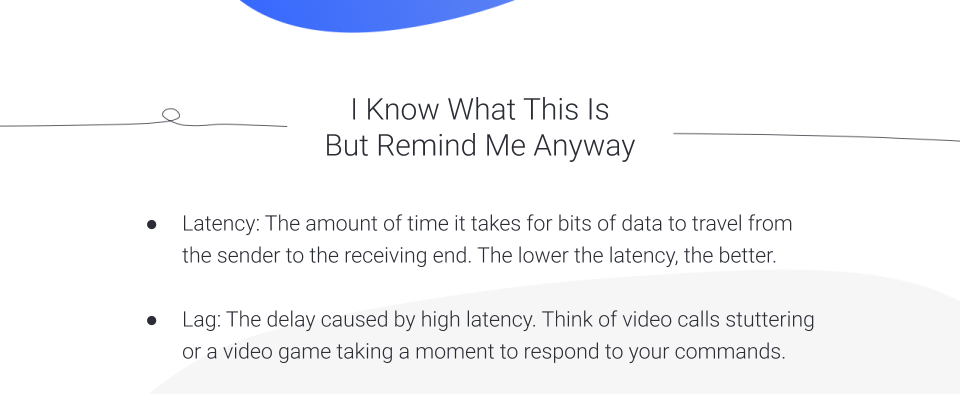There are a few natural enemies to streaming media in real-time (aka WebRTC) and chief among them are jitter and latency. Before you panic, these nuisances are easily dealt with.
What Is Jitter in VoIP?
So what is jitter, and what is latency? And for that matter, what is packet loss? These terms often come as a packet deal (yes, we fully intended that pun).
When you’re streaming something in real-time, whether it’s a broadcast of your local game or, more to the point of this blog, a video call for work, you may notice some hiccups in your feed.
These hiccups appear as though your monitor blinked in the middle of the call and missed a blip of the stream. The technical term for these blips is packet loss. Insufficient Internet bandwidth leads to packet loss. Packet loss leads to jitter. Jitter leads to the dark side—oops, we mean latency.
Now, you’re going to experience a little bit of these all the time, and that’s normal! It only becomes an issue when they add up to noticeable levels. We’re talking about a participant’s screen freezing as they’re about to introduce the new CEO. Or your audio cutting in and out making it hard for you to follow, let alone jump into, the conversation.

VoIP Jitter Terms
- Packet: A collection of bytes of digital data that can be transmitted over the Internet.
- Packet Loss: When packets are lost during transmission of a VoIP call, call quality degrades.
- Jitter or Lag: Variation in packet transit delays. As the speed of transmission fluctuates, individual packets of data can arrive out of sync, harming call quality (e.g., choppy sound).
- Latency: Amount of time it takes for sound to travel from one call participant to another. A latency of 150 milliseconds (ms) is barely noticeable, so it is acceptable.
Acceptable Jitter for VoIP
It seems odd to say there are acceptable levels of call issues, but a certain amount of jitter is normal. So, what is considered acceptable jitter for VoIP?
Both jitter and latency are measured in milliseconds. Packets are so small that the human senses honestly don’t pick up on a few drops here and there. Acceptable levels are less than 30ms for network jitter and under 150ms for latency. Keep in mind, a human blink is about 400ms. A key step in setting up your business VoIP service is to run a VoIP latency and jitter test on your office network to make sure it can handle VoIP traffic.
Luckily today, decades after Internet communications debuted, it’s practically guaranteed that any system can smoothly handle cloud VoIP without sacrificing quality. After all, we’re in the 5G era, when streaming HD movies on your phone is commonplace.
Common Causes for VoIP Jitter
It can be difficult to pinpoint exactly what is causing a specific VoIP jitter problem, but here are three main culprits:
- Inadequate Internet bandwidth
- Outdated Internet equipment
- Overcrowded wireless networks
On the bright side, since these are well-known issues, the fixes are equally well known.
- Increase bandwidth speed—you may need a new Internet service provider
- Upgrade your router to a model with built-in voice packet prioritization technology
- Connect to the Internet with Ethernet cables instead of Wi-Fi®
- Replace old Ethernet cables with premium ones
Quick fix: If you’re on a video call that starts to get choppy, ask the participants to turn off their cameras.
While that will probably keep your meeting moving along, it doesn’t get to the root of the problem. For more help, check out these blog posts:
VoIP Troubleshooting: 4 Common VoIP Problems & How to Solve Them
Remote Work Tips: How to Improve Conference Call Quality in Your Home Office

